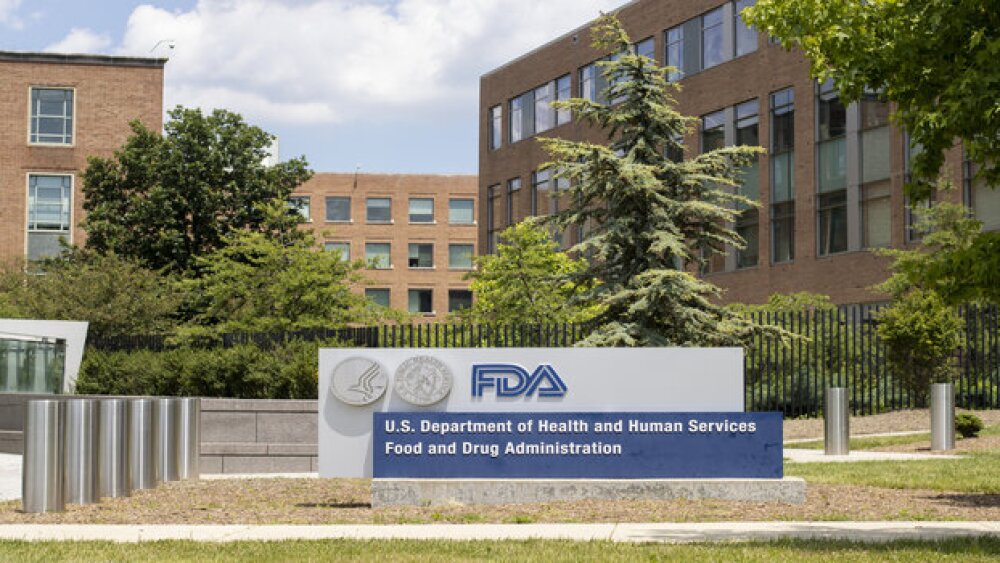SOUTH SAN FRANCISCO, Calif., Dec. 30 /PRNewswire-FirstCall/ -- Genentech, Inc. announced today that it has submitted a Biologics License Application (BLA) to the U.S. Food and Drug Administration (FDA) for the use of Lucentis(TM) (ranibizumab) in the treatment of neovascular wet age-related macular degeneration (AMD). Lucentis is the first therapy for wet AMD to have shown improved vision in two pivotal Phase III trials and demonstrated a clinical benefit over verteporfin (Visudyne(R)) photodynamic therapy (PDT) in a head-to-head clinical trial. As part of the Lucentis BLA submission, Genentech has requested a Priority Review designation from the FDA, which, if granted, would give the FDA six months from the Agency's receipt of the submission to take action on the application.
The BLA submission is based on one-year clinical data on the efficacy and safety of Lucentis from two pivotal Phase III trials, ANCHOR and MARINA, as well as one-year clinical data from the Phase I/II FOCUS trial. In addition to these registrational studies, Genentech is currently enrolling patients with wet AMD in a Phase IIIb safety study called SAILOR. Data from the Phase IIIb PIER study evaluating a less frequent dosing regimen for Lucentis are anticipated in the first half of 2006.
"This application represents a summary of data from more than six years of rigorous clinical study and the dedication of thousands of patients and physicians hoping to improve outcomes for those with this devastating disease," said Hal Barron, M.D., Genentech's senior vice president of Development and chief medical officer. "We look forward to working with the FDA in our efforts to bring this potential therapy to patients quickly as it may offer benefit to patients with all types of wet AMD."
ANCHOR
In November 2005, Genentech announced positive preliminary data from the pivotal Phase III ANCHOR study (ANti-VEGF Antibody for the Treatment of Predominantly Classic CHORoidal Neovascularization in AMD), a randomized, two-year, multi-center, double-masked, active-treatment controlled study comparing two different doses of Lucentis to PDT in 423 patients with predominantly classic wet AMD. Approximately 94 percent of patients treated with 0.3 mg of Lucentis and 96 percent of those treated with 0.5 mg of Lucentis maintained (defined as a loss of less than 15 letters in visual acuity) or improved vision (defined as a gain of 15 letters or more) compared to approximately 64 percent of those treated with PDT alone [p<0.0001] during the first year of the two-year study. The Lucentis treatment groups further showed a statistically significant difference from the control arm in an important secondary endpoint: mean change in visual acuity (VA) from baseline to month 12. On average, VA among patients treated with Lucentis improved, while VA among patients treated with PDT declined. Based on these results, patients in the PDT-alone arm of the study will have access to Lucentis for the remainder of the study. One-year data from the ANCHOR study will be presented at the Macula 2006 meeting in New York in January.
MARINA
In July 2005, Genentech presented positive preliminary one-year results from the pivotal Phase III MARINA study (Minimally classic/occult trial of the Anti-VEGF antibody Ranibizumab In the treatment of Neovascular AMD), a randomized, two-year, multi-center, double-masked, sham-injection controlled study evaluating the safety and efficacy of two different doses of Lucentis in 716 patients with minimally classic or occult wet AMD. Nearly 95 percent of patients treated with Lucentis maintained or improved vision at 12 months. Additional one-year results include:
-- Twenty five percent (59/238) of patients treated with 0.3 mg of Lucentis and 34 percent (81/240) treated with 0.5 mg of Lucentis improved vision by a gain of 15 letters or more compared to approximately 5 percent (11/238) of patients in the control group as measured by the ETDRS eye chart. -- Nearly 40 percent (188/478) of Lucentis-treated patients (38.7 percent in the 0.3 mg group and 40 percent in the 0.5 mg group) achieved a visual acuity score of 20/40 or better compared to 11 percent (26/238) in the control group. -- Patients treated with Lucentis gained an average of approximately seven letters in visual acuity (6.5 letters in the 0.3 mg group and 7.2 letters in the 0.5 mg group) compared to study entry, while those in the control group lost an average of 10.5 letters. -- The majority of patients treated with Lucentis (349/478) (74.8 percent in the 0.3 mg group and 71.3 percent in the 0.5 mg group) experienced a letter improvement of zero or more compared to 28.6 percent (68/238) in the sham group.
In October 2005, Genentech announced that patients still in the sham arm of the MARINA study would be crossed over to active treatment with Lucentis.
FOCUS
The FOCUS trial (RhuFab V2 Ocular Treatment Combining the Use of Visudyne(R) to Evaluate Safety) is a randomized, two-year, multi-center, single-masked study evaluating the safety, tolerability and efficacy of Lucentis in combination with PDT compared to PDT alone in 162 patients with predominantly classic subfoveal wet AMD. Preliminary one-year data were presented in July 2005 and showed that approximately 90 percent of patients maintained or improved vision when treated with the combination of Lucentis and PDT compared to approximately 68 percent of those treated with PDT alone (p = 0.0003).
Lucentis Safety Profile
In clinical trials to date, the most common side effects that occurred more frequently in the Lucentis arms (0.3 mg and 0.5 mg) than in the control arms were mild to moderate and included: conjunctival hemorrhage, eye pain, increased intraocular pressure and vitreous floaters.
Serious ocular adverse events that occurred more frequently in the Lucentis-treated arms were uncommon and included endophthalmitis and intraocular inflammation (less than 1 percent for each). Among non-ocular serious adverse events, cerebral vascular events and myocardial infarctions were observed in all three arms of both the Phase III MARINA and ANCHOR studies; in each study the combined rate of these events was similar in the control and the 0.3 mg Lucentis arms and slightly higher in the 0.5 mg Lucentis arm. Cerebral vascular events and myocardial infarctions were also seen in the Phase I/II study of Lucentis 0.5 mg in combination with Visudyne PDT (FOCUS), although the combined frequency of these events was approximately equal in both treatment arms.
Additional Phase III Studies
SAILOR
In November 2005, Genentech began enrollment in a Phase IIIb study, SAILOR, to make Lucentis available to eligible patients. SAILOR (Safety Assessment of Intravitreal Lucentis fOR AMD) is a Phase IIIb clinical study of Lucentis for patients with all types of new or recurrent active subfoveal wet AMD. It is a one-year study designed to evaluate the safety of two different doses (0.3 mg and 0.5 mg) of Lucentis administered once a month for three months and thereafter as needed based on retreatment criteria. The study will be conducted at more than 100 sites in the United States and will enroll up to 5,000 patients. Those interested in additional information about the study can call toll-free 1-888-662-6728.
PIER
Genentech is also conducting PIER (A Phase IIIb, Multi-center, Randomized, Double-Masked, Sham Injection-Controlled Study of the Efficacy and Safety of Ranibizumab in Subjects with Subfoveal Choroidal Neovascularization with or without Classic CNV Secondary to Age-Related Macular Degeneration) with 184 patients in the United States. In this trial, Lucentis is administered once per month for the first three months followed thereafter by doses once every three months for a total of 24 months. Enrollment in this study is complete and preliminary results are expected in the first half of 2006.
About AMD
AMD is a major cause of painless central visual loss and is the leading cause of blindness for people over the age of 60. The National Eye Institute estimates that there are 1.6 million people with AMD in the United States alone and that this prevalence will grow to 2.95 million by 2020. AMD occurs in two forms: dry and wet.
The dry form is associated with atrophic cell death of the central retina or macula, which is required for fine vision used for activities such as reading, driving or recognizing faces. The wet form is caused by growth of abnormal blood vessels also known as choroidal neovascularization (CNV) or ocular angiogenesis under the macula. These vessels leak fluid and blood and cause scar tissue that destroys the central retina. This results in a deterioration of sight over a period of months to years.
About Lucentis
Lucentis(TM) (ranibizumab) is a humanized therapeutic antibody fragment developed at Genentech and designed to bind and inhibit VEGF-A, a protein that is believed to play a critical role in angiogenesis (the formation of new blood vessels). Lucentis is designed to block new blood vessel growth and leakiness, which lead to wet AMD disease progression and vision loss.
Lucentis is being developed by Genentech and the Novartis Ophthalmics Business Unit. Genentech retains commercial rights for Lucentis in North America. Novartis has exclusive commercialization rights for the rest of the world.
About Angiogenesis
Genentech is a leader in research and product development in the area of angiogenesis, the process by which new blood vessels are formed. In 1989 Napoleone Ferrara, M.D., and a team of scientists at Genentech conducted seminal work in the field, which resulted in the identification and cloning of a gene termed Vascular Endothelial Growth Factor (VEGF), now known as VEGF-A. The VEGF-A protein is believed to play a critical role in angiogenesis and serves as one of the key contributors to physiological or pathological conditions that can stimulate the formation of new blood vessels. The process of angiogenesis is normally regulated throughout development and adult life, and the uncontrolled growth of new blood vessels is an important contributor to a number of pathologic conditions, including wet AMD.
About Genentech
Genentech is a leading biotechnology company that discovers, develops, manufactures and commercializes biotherapeutics for significant unmet medical needs. A considerable number of the currently approved biotechnology products originated from, or are based on, Genentech science. Genentech manufactures and commercializes multiple biotechnology products directly in the United States and licenses several additional products to other companies. The company has headquarters in South San Francisco, Calif., and is traded on the New York Stock Exchange under the symbol DNA. For additional information about the company, please visit http://www.gene.com .
This press release contains forward-looking statements regarding Lucentis as a potential therapy and the expected time frame for the PIER trial results. Actual results could differ materially. Among other things, the time frame for the PIER results could be affected by unexpected safety or efficacy issues, additional time requirements to achieve study endpoints or for data analysis, or discussions with the FDA or FDA actions; and Lucentis as a potential therapy could be affected by certain of the forgoing and the failure to receive FDA approval, competition, pricing and the ability to supply product or a product withdrawal. Genentech disclaims any obligation and does not undertake to update or revise the forward-looking statements in this press release.
Media Contact: Dawn Kalmar 650-225-5873
Investor Contact: Kathee Littrell 650-225-1034
Patient Inquiries: 1-888-662-6728
Genentech, Inc.CONTACT: media, Dawn Kalmar, +1-650-225-5873, or investors, KatheeLittrell, +1-650-225-1034, or patients, 1-888-662-6728, all of Genentech
Web site: http://www.gene.com/




